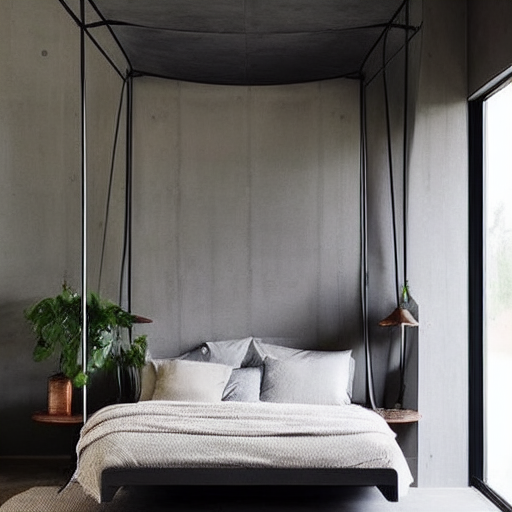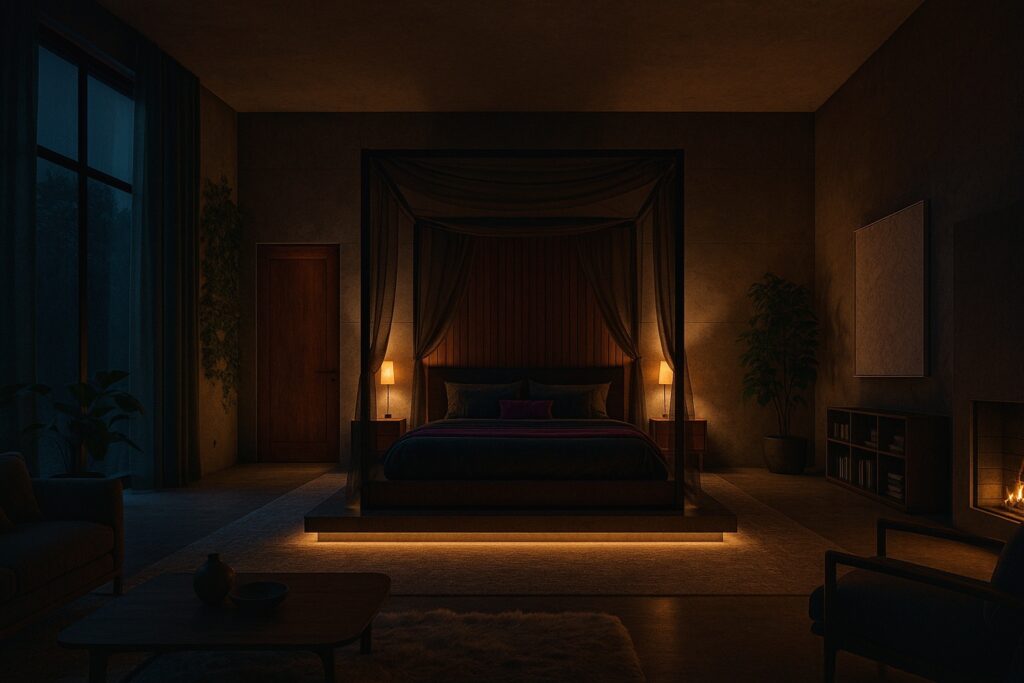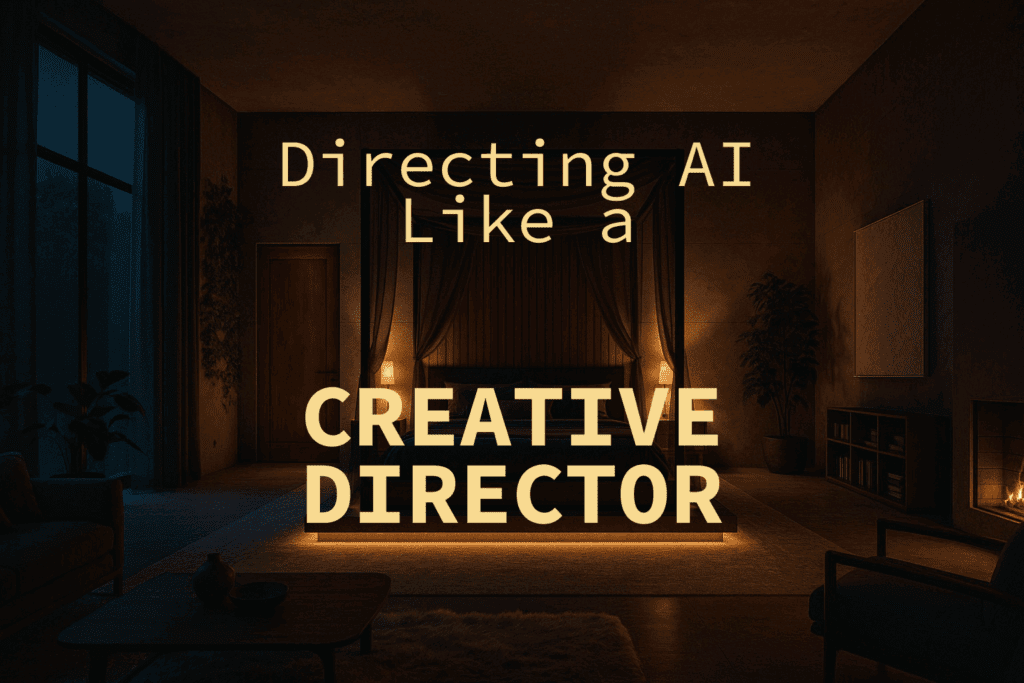Everyone’s got a vision they’d love to see come to life. Maybe it’s a brand identity, a slick marketing brochure, a quirky illustrated character, a product concept, or even a moody cinematic interior. Generative AI promises to make that happen: just describe what you want and watch it pop up on your screen.
Except… not really. If you’ve tried it, you already know the truth: what you get back is usually “close, but no cigar.” Colors feel off. Proportions are weird. The mood is mismatched. Sometimes it looks good, but it’s not your good—it doesn’t line up with the actual intent of your project.
That’s because AI isn’t a mind reader. It doesn’t know what you mean by “modern,” “playful,” or “minimal.” It makes its own assumptions, and surprise surprise, you end up with results that feel generic or just plain wrong.
This is where creative direction comes in. In traditional creative fields like photography, film, or design, the director isn’t necessarily the one pressing the shutter or adjusting the software. They’re the one setting the vision, guiding the team, and making sure all the little details serve the bigger picture. They’re the bridge between an abstract idea and a tangible result.
AI works the same way. You don’t need to know the math behind a machine learning model any more than a director needs to understand the engineering behind a camera lens. What you do need is the ability to:
- Translate taste into specifics.
- Structure feedback into actionable steps.
- Iterate through dialogue instead of demanding instant perfection.
When you step into the role of creative director with AI, the quality of your results jumps. A vague “make it modern” prompt gets you something forgettable. But a structured brief like “flat vector logo, geometric sans serif font, two-color palette with high contrast, balanced 60/40 between icon and wordmark” produces something intentional.
This blog is a guide to that process. Drawing from real project work, we’ll walk through 10 principles of directing AI, plus a checklist you can use across almost any medium—logos, cartoons, brochures, architectural visualizations, you name it.
The goal isn’t to make you a “prompt engineer.” The goal is to help you think like a creative director: someone who knows how to bring a vision to life by guiding, refining, and shaping what AI produces.
Why Creative Direction Matters in AI
Think of a professional photoshoot. On set, the director isn’t the one clicking the shutter or moving the lights. Instead, they set the mood. Are we going bright and energetic or dark and dramatic? They guide the photographer on framing, suggest tweaks to wardrobe, and give feedback on poses—all without touching the gear.
Their value lies in holding the vision and translating it into direction that others can execute.
Working with generative AI is the same. The AI is your crew. It can handle the technical heavy lifting—drawing, composing, rendering, writing—but it doesn’t know what you mean by “bold” or “playful.” Without you steering, it fills in the blanks however it wants. That’s how you end up with results that look fine but feel wrong.
Your role as creative director looks just like it would on set:
- Set the vision and tone.
- Give structured feedback to refine outputs.
- Spot when something aligns (or doesn’t).
- Make decisive calls when options are fuzzy.
Notice what’s missing? Deep technical knowledge. Just like a creative director doesn’t need to know every part of camera engineering, you don’t need to understand model math. What matters is your ability to translate vision into direction and guide outputs toward it.
When you stop treating AI like a magic box and start treating it like a creative team, the whole dynamic shifts. You’re no longer crossing your fingers that it “gets it right.” You’re directing—and the results start to feel like yours.
A Creative Project Example
Imagine you want to use AI to visualize a creative concept—in this case, an architectural interior space. A beginner might write a prompt like:
“A brutalist bedroom with a canopy bed. The walls are concrete. There’s some wood. Add windows and plants. Modern and stylish.”

Sounds fine, right? But prompts like this leave massive gaps. What kind of wood? How large are the windows? Where should the plants go? What does “modern and stylish” even mean? Without specifics, the AI improvises—and the result is often generic, awkwardly proportioned, or lifeless.
That’s exactly what happened in our “before” example. The outputs had the right elements—concrete, a canopy bed, plants—but the scene lacked cohesion. The bed was out of scale, the lighting was flat, and the mood missed the cinematic feel we wanted.
Things changed once the prompt turned into a creative brief. Instead of “some wood,” it became “a feature wall in vertical walnut slats behind the bed.” Instead of “add windows,” it was “floor-to-ceiling glass panes with black steel frames on the left wall.” The canopy bed became “a centered dais platform, proportioned to 40% of the frame, with a matte black canopy and sheer mesh curtains.”
Color accents shifted from the default teal to bold fuchsia. Composition rules were added: bedding grounds the bottom third, curtains frame from the top, oak door dead center. Lighting was layered deliberately: sconces for warmth, underglow for drama, moonlight for contrast.
With each round of feedback, the AI results got sharper. The vague “brutalist bedroom” turned into a cohesive cinematic space with depth and personality.
The lesson isn’t about architecture. It’s about process. Moving from broad, vague inputs to structured, decisive direction. That’s how you bridge the gap between “AI-generated” and “AI-directed”—a shift that applies equally to logos, brochures, cartoons, or any creative medium.

The 10 Core Principles of Directing AI
1. Anchor with a North Star
Every project needs a compass. Before diving into prompts, nail down the vision: playful, cinematic, minimalist, bold, warm? Without this “north star,” outputs scatter.
- Logo: Define the brand identity first—luxury minimalism, eco-friendly organic, streetwear boldness.
- Cartoon: “Lighthearted and family-friendly.”
- Brochure: “Sleek, professional, investor-facing.”
This guiding principle keeps every decision tethered to a shared vision.
2. Translate Taste into Specifics
AI doesn’t get vague descriptors like “modern” or “cool.” Translate taste into tangible design tokens.
- Instead of: “Make it modern.”
- Say: “Flat vector illustration, geometric sans serif font, two-color palette with high contrast.”
The more concrete the input—fonts, ratios, colors, textures—the less room AI has to misinterpret.
3. Zone the Work into Parts
Big projects work better when split into logical sections. This keeps AI from blending everything together.
- Logo: Icon, typography, tagline.
- Cartoon: Character, environment, props.
- Brochure: Cover, inside spread, back panel.
Think like an architect: define the “zones” before filling in details.
4. Use Positive Language
AI struggles with negatives. “Don’t make it busy” leaves it guessing. Instead, describe what you do want.
- Bad prompt: “Don’t make the logo 3D.”
- Good prompt: “Flat vector logo with two layers of depth max.”
Always direct toward what you want, not away from what you don’t.
5. Resolve Ambiguity
If you’re vague, AI fills in the blanks. Instead of “maybe plants,” say “climbing ivy wall.” Instead of “neutral palette,” pick cream, slate gray, muted green.
Specific choices cut through randomness. They make outputs feel intentional rather than accidental.
6. Quantify Composition
Numbers make things real. Composition rules help AI stage outputs deliberately.
- Logo: “Icon 2:1 ratio with wordmark.”
- Cartoon panel: “Foreground character fills left third, background fills right two-thirds.”
- Brochure: “Header = 20% vertical space, body text = 60%, footer = 20%.”
Ratios, grids, rules of thirds—all of it adds clarity.
7. Layer Emphasis and Tone
Hierarchy matters. Define which elements lead and which support.
- Copywriting: Headline > supporting copy > CTA.
- Design: Hero image > supporting images > background.
- Lighting: Warm sconces for focus, moonlight for mood, underglow for accent.
Layering creates depth and direction.
8. Iterative Critique
Treat AI like a junior designer: review, refine, repeat. Each round should note what worked, what to tweak, and what to keep.
- Formula: Affirm → Specific delta → Lock progress.
- Example: “Great color palette. Increase contrast in the typography. Keep the icon as is.”
This structured loop keeps progress moving forward instead of sideways.
9. Lock Approved Elements
Protect wins. If the typography works, lock it in. If proportions are right, don’t let later rounds undo them.
- Logo: “Typography locked—explore icon variations.”
- Brochure: “Layout grid approved—refine photography.”
AI likes to re-randomize. Locking prevents creative backsliding.
10. Think Like a Director
You don’t have to micromanage every pixel. Your role is to set the scene, establish tone, and guide the outputs. Just like a director on set: they don’t hold the camera, but they call the shots on mood, framing, and story.
- Animation: Define pacing, lighting, and tone.
- Copy: Specify rhythm (short punchy sentences vs. long flowing paragraphs).
- Design: Suggest angle, rule of thirds, or contrast emphasis.
Directing AI is about holding the vision and guiding it to life.
Iteration and Feedback Loops
AI rarely nails it in one go. It works best as a conversation: back-and-forth, each round moving closer to the vision. That’s where the creative director role shines.
Dialogue, Not Vending Machine
A big misconception: if the prompt is “good enough,” AI should spit out a final. But creative work doesn’t work that way. Directors don’t expect the first sketch or photo to be flawless. They guide, refine, and adjust. Same with AI: progress comes through prompts shaped by feedback, not one “perfect” input.
Building a Shared Vocabulary
In our interior design project, things clicked once we introduced terms like “dais bed,” “mesh canopy curtains,” and “rule of thirds.” These became shorthand. Every creative field has its own vocabulary. Part of directing AI is deciding which words anchor the project.
Interim Outputs as Checkpoints
Each render or draft isn’t a failure if it’s not final. It’s a checkpoint—a way to measure alignment. Too big a bed? Too flat lighting? That’s just information. The AI shows where assumptions still need correction. Checkpoints keep momentum moving.
The Feedback Formula
The most effective critique loop followed a simple rhythm:
- Affirm what works. (“The color palette feels strong.”)
- Specify the delta. (“Shrink the canopy to match the bed’s scale.”)
- Lock progress. (“Keep the oak door centered as is.”)
This pattern prevents regression, where good elements get lost.
Universal Application
This loop works for logos, copy, brochures, video pacing—you name it. By treating outputs as drafts to refine, not finals to judge, you build momentum toward alignment.
Takeaway: Iteration isn’t wasted effort. It’s the core of creative direction with AI—the space where raw possibility becomes an intentional result.
Applying the Framework Across Mediums
The strength of this framework is its flexibility. Whether it’s visuals, text, or multimedia, the principles hold. You’re directing AI like a creative partner.
- Logos: Anchor the style to brand values (luxury minimalism, bold streetwear, eco-friendly organic). Zone the work into icon, wordmark, tagline. Quantify proportions (“icon 60%, wordmark 40%”). Lock typography, then refine symbol.
- Cartoons and Illustrations: Break the scene into characters, environment, props. Define proportions (“head-to-body ratio 1:3, chibi style”). Emphasize main character, soften background. Once style is right, iterate poses and expressions.
- Brochures: Zone into cover, inside spread, back panel. Quantify grid rules (two-column interior with 20% margins). Lock typography hierarchy. Define visual flow: hero image first, icons second, body copy last.
- Websites and Digital Products: Anchor tone (trustworthy, innovative, approachable). Zone into hero, nav, body, footer. Quantify spacing (hero = top 25%, CTA above fold). Once flow is aligned, refine visuals.
- Copywriting: Break into headline, supporting copy, CTA. Anchor tone (playful vs. authoritative). Lock voice, then adjust clarity and rhythm. Use the feedback loop to balance persuasion with readability.
- Video and Animation: Anchor style (cinematic, motion graphics, anime-inspired). Zone into opening, body, closing. Quantify pacing (“5-sec opener, 20-sec body, 5-sec outro”). Lock character design before animating motion.
Takeaway: No matter the medium, your role is the same: break work into zones, define specifics, and guide outputs toward cohesion.
Common Pitfalls
Even with the best intentions, a few mistakes derail projects:
- Being too vague: “Make it fun” won’t cut it.
- Mixing incompatible styles: “Minimalist and maximalist” in the same prompt? Chaos. Pick an anchor style.
- Overusing negatives: “Don’t make it busy” confuses models. Say “simple, white-space-driven layout.”
- Changing too much at once: Adjusting color, composition, and typography all together means you won’t know what worked.
- Forgetting to lock progress: If you don’t freeze wins, AI backslides and re-randomizes.
Tip: At each iteration, state what’s locked and what’s still open. This mirrors how professional creative teams avoid rework.
The Creative Director’s Prompt Checklist
A quick reusable checklist for any project:
- Context: What’s the overall style and tone? (primary + secondary influences)
- Zones/Parts: Break down work into logical sections (logo, brochure panels, character/environment).
- Composition: Specify ratios, layout, framing, hierarchy.
- Features: Identify concrete elements—colors, typography, textures, props.
- Emphasis: Clarify hierarchy of importance (headline > body > CTA; hero image > supporting visuals).
- Keep: What’s already approved and locked?
- Change: What needs refinement in this round?
- Mood: What’s the intended emotional outcome?
This checklist turns abstract taste into structured direction—for you and for AI.
The Future of Human–AI Creative Work
The relationship between humans and AI is evolving fast. But one thing’s clear: the winners won’t just be people who use AI, but people who know how to direct it.
Generative models are insanely capable—they can draft copy, render images, storyboard animations, even compose video. But capability isn’t alignment. Without human guidance, outputs drift into generic clichés. The bottleneck isn’t the tech—it’s clarity of direction.
Here’s where humans shine. You’re not just the maker, you’re the director. You bring taste, context, and judgment that AI can’t replicate. You define what matters in ways no dataset can: the emotional punch of a headline, the cultural nuance of a phrase, the subtle warmth of a palette.
As tools get easier, the challenge won’t be using them. It’ll be articulating vision and shepherding it through iteration. The people who master this will scale creativity across mediums and timelines without losing quality.
AI doesn’t erase creativity—it raises the bar. The best creative leaders will be the ones who can translate vision into structured, iterative direction.
Conclusion
Generative AI has reshaped creative work. Left unguided, it churns out results that are generic, inconsistent, or just “off.” The difference between disappointment and delight isn’t the model you pick—it’s the role you play.
When you step into the role of creative director, you shift from passive user to active shaper of results. You:
- Anchor projects with a clear north star.
- Translate taste into specifics.
- Break work into zones and direct composition.
- Layer emphasis and mood.
- Refine outputs through iteration and feedback.
- Lock what works and build forward.
This isn’t about becoming a “prompt engineer.” It’s about treating AI like a collaborator—a powerful assistant that needs guidance, structure, and critique.
The bottom line: if you can give good feedback to a designer, writer, or photographer, you can direct AI. The skills are the same, only the medium has changed.
So next time you use AI—whether for a logo, a brochure, a character design, or a cinematic interior—don’t just ask it to create. Direct it. Bring your vision, guide it through the loop, and watch the results finally match what you imagined.


